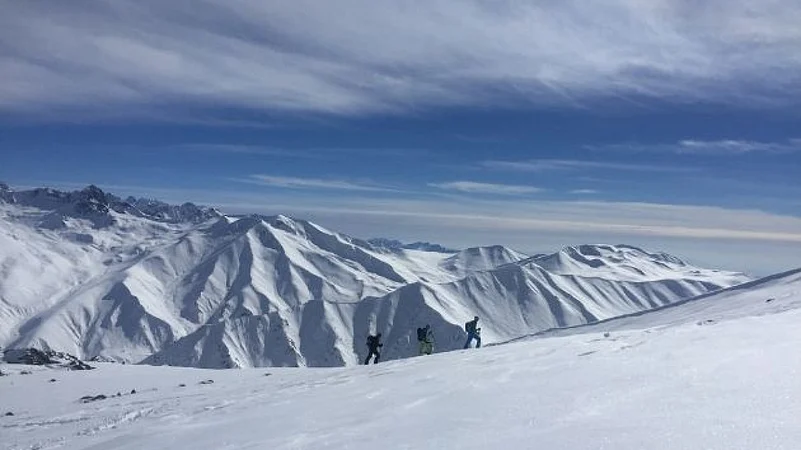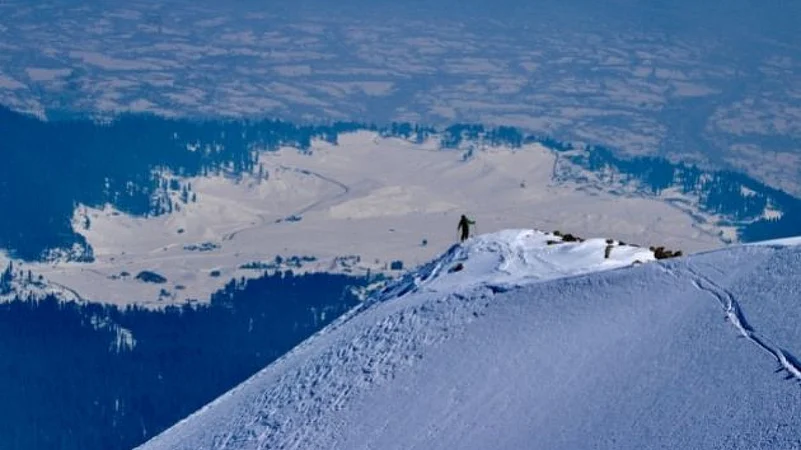Kashmir’s famed ski resort Gulmarg has often been described as a place with the potential to become Davos for the South Asian countries. On January 6, industrialist Anand Mahindra shared some exquisite pictures of Kashmir, blanketed with snow. The chairman of Mahindra Group wrote, “Hello Srinagar. Goodbye Switzerland…” The pictures shared by him were mostly from Gulmarg.?
With Parts Under Army Control, Can Gulmarg Still Be Davos Of The East?
The Centre’s decision to declare 70 hectares of land as 'strategic areas' in tourism hotpots Gulmarg and Sonamarg in Jammu & Kashmir trigger concern among skiers and tourist operators, who fear losing business

Earlier, on January 14, 2018, NITI Aayog CEO Amitabh Kant, tweeted from Gulmarg: “Forget Davos! 100X more gorgeous & exotic is our very own Gulmarg! It’s simply stunning in winter season!” Much earlier, on April 30, 2015, the then Chief Minister Mufti Mohammad Sayeed said the government intended to promote Gulmarg in Kashmir as the Davos of India, where the country’s top business and policymakers could hold their annual summits to frame new policies and strategies.
The idea of Gulmarg as Davos was first floated by economist Swaminathan S Anklesaria Aiyar on January 29, 2005, in an article. He wrote: “The world’s biggest capitalist get-together, the annual meeting of the World Economic Forum at Davos, Switzerland, has started this week... Change is in the air. This is what the inaugural speech in 2035 will sound like: Ladies, gentlemen and transvestites (no gasps of surprise please, true capitalism recognises no gender boundaries). Let me welcome you to the annual meeting of the World Economic Forum in Gulmarg. This brings to a happy end the recrimination that, sadly, has paralysed our organisation for several years. You will recall that Chinese businessmen began boycotting Davos in 2020 on the ground that China was now richer than any European country, and so the annual meeting should be held at Shanghai. Then last year, Indian businessmen joined the boycott, pointing out that India had surpassed not only every European country but also Japan in GNP (as was predicted with uncanny accuracy by the CIA in 2004-05). I am glad to say that we have reached an amicable resolution: the annual meeting will now be held in rotation every three years in Davos, Shanghai and Gulmarg.”
?

Cut to January 6, 2022, Mufti’s daughter and former Chief Minister Mehbooba Mufti tweeted: “Allocating thousands of kanals to armed forces that too in tourist areas confirms GOIs intention to convert J&K into a military garrison. Under the ‘state land’ pretext, our land is up for grabs & to add insult to injury locals are being evicted from their homes.”
?
Mehbooba’s reaction came after the government’s decision to declare around 1,358 kanals (169.75 acres) as “strategic areas” in the tourism hotpots, Gulmarg and Sonamarg in the north and central Kashmir. According to an order issued by the Tourism Department, 1,034 kanals and six marlas of land in Gulmarg and 354 kanals in Sonamarg have been notified as strategic areas by the authorities, exercising power under the Jammu and Kashmir Development Act.
What is strategic area? In 2020, the J&K administration approved amendment to the Control of Building Operations Act, 1988, and the J&K Development Act, 1970, to allow notifying any areas in J&K as “strategic areas” where the Indian armed forces can carry out unhindered constructions and other related activities they deem needful through a special dispensation. This is being compared with the notification of the disturbed area issued under the Armed Forces Special Powers Act (AFSPA). Once the area is declared disturbed under AFSPA, the armed forces have impunity from prosecution. Similarly, the Armed forces, under the J&K Development Act can notify any area in J&K as a “strategic area” and then carry out constructions.
?

The government has declared 1,358 kanals as the strategic area at a time when the demilitarization of the Siachen Glacier seems to be under consideration. Its first indication came from the Indian Army Chief, General MM Naravane, who said in a statement recently that India was not averse to demilitarisation of the Siachen Glacier provided both sides accept their actual ground position line.
The move to hand over land to the Army for strategic areas has perturbed skiers and tourist operators. They say that both Nagin 1 and Nagin 2 areas have already been declared “No Go Zone”, which has limited backcountry skiing in Gulmarg. They fear the Army might build the infrastructure according to its own requirements, freezing many more areas for skiing. Besides, they fear that the foreign skiers, who often visit Gulmarg in spite of travel advisory, would not like to travel to a place declared by the government as “strategic area.”?
- Previous Story
 Elections 2024: Ashok Tanwar Joins Congress Again; Sehwag Endorses Congress Candidate In Haryana
Elections 2024: Ashok Tanwar Joins Congress Again; Sehwag Endorses Congress Candidate In Haryana - Next Story
























